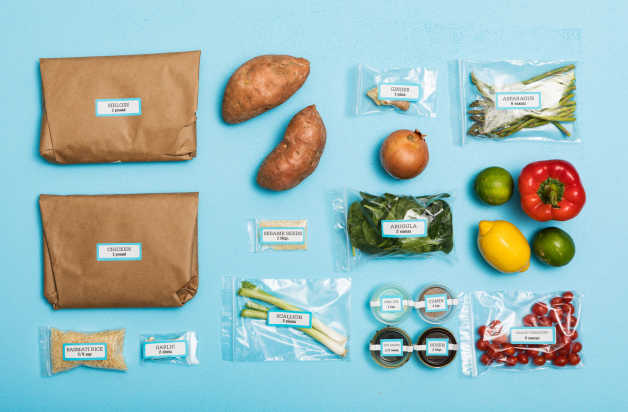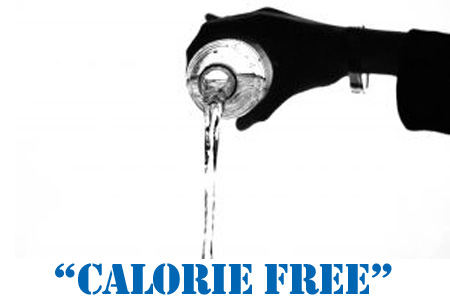44 how many calories are food labels based on
The Science Behind Calories and Nutrition Facts Labels The calorie number we see on food labels refers to a kilocalorie (kcal), which is also known as a large calorie or a food calorie. A kilocalorie is 1 000 calories. One kilocalorie is the amount of energy it takes to heat one kilogram of water one degree Celsius at sea level. Calorie counts on nutrition labels may not be that precise - Los ... Science & Medicine Calorie counts on nutrition labels may not be as precise as you think A shopkeeper weighs almonds for a customer. Almonds used to have about 170 calories per serving, then...
How to Understand and Use the Nutrition Facts Label | FDA That is two times the calories and nutrients shown in the sample label, so you would need to double the nutrient and calorie amounts, as well as the %DVs, to see what you are getting in two...

How many calories are food labels based on
How to Read the Nutrition Facts Label on Packaged Foods Sodium. Many people get far too much salt, or sodium. Most of it is in packaged foods and restaurant items. Limit salt to 2,300 milligrams (about 1 teaspoon) daily. If you have high blood pressure ... How To Read Food and Beverage Labels - National Institute on Aging The percent Daily Value (% DV) tells how much a nutrient in a serving of the food or beverage contributes to a total daily 2,000-calorie diet. Although the average person needs 2,000 calories a day to maintain their weight, individuals may need more or fewer depending on their lifestyle. Food Labels (Lesson 15) - LSU AgCenter The Nutrition Facts label is found on food packages and shows the amount of calories per serving, servings per container, specific nutrients and the amount of each nutrient given in grams and percent daily value based on a 2,000-calorie diet.
How many calories are food labels based on. Food Labels: Carbohydrates | Home & Garden Information Center That means carbohydrates should supply 900 calories or more in a 2,000-calorie-a-day diet. Facts on Food Labels. Food labels contain clues to a food's carbohydrate content, including the amount per serving. ... for total carbohydrate is 300 grams (g) or 100% DV, based on a 2,000-calorie diet. This number combines several types of ... Reading Food Labels (for Parents) - Nemours KidsHealth The information on food labels is based on an average diet of 2,000 calories per day. But the actual number of calories and nutrients that kids need will vary according to their age, weight, gender, and level of physical activity. (For more guidance, check out the USDA's MyPlate .) Total Fat 5 tips for decoding food labels - Harvard Health If the label says 125 calories per 8 ounce serving and your breakfast includes a 16 ounce glass of OJ, then you've taken in 250 calories from the juice alone. (About as many calories as you'd find in many chocolate bars.) Look for fat: the good, the bad, and the really bad. Check the saturated fat and trans fat content of the food. How to Read Food Labels Without Being Tricked - Healthline Nutrition labels state how many calories and nutrients are in a standard amount of the product — often a suggested single serving. However, these serving sizes are frequently much smaller than what...
How to Read Food Labels for a Heart-Healthy Diet - Hopkins Medicine The correct answer is A 2,000-calorie-a-day diet. The percent daily value numbers on a Nutrition Facts label are based on a 2,000-calorie diet. You may need to eat more or fewer calories and nutrients depending on your size, health status, health goals and doctor's recommendation. Food Calorie Calculator Food Calorie Calculator Powered by the USDA National Nutrient Database, the Food Calorie Calculator below allows you to choose from thousands of foods and brands, and see nutrition facts such as calories, fat, protein, carbohydrates, fiber and sugar. Get started by entering your food and drink choices under "Keywords". Calories on the New Nutrition Facts Label | FDA One package of food may contain more than one serving, so, if you eat two servings you would be getting two times the calories shown on the label. For example, if you ate one serving of the food... Understanding Food Nutrition Labels - American Heart Association Remember that the information shown in the label is based on a diet of 2,000 calories a day. You may need less or more than 2,000 calories depending upon your age, gender, activity level, and whether you're trying to lose, gain or maintain your weight.
Food Labels | Nutrition.gov What's New with the Nutrition Facts Label. HHS, Food and Drug Administration. The U.S. Food and Drug Administration (FDA) has updated the Nutrition Facts label on packaged foods and beverages with a fresh design that will make it easier for you to make informed food choices that contribute to lifelong healthy eating habits. What's in a Name? How to Read Food Labels & Count Carbs | Allulose A food or beverage with a total fat PDV of 10% provides 10% of the total fat someone on a 2,000 calories per day diet should eat. The same goes with cholesterol and sodium. Keeping these in check, and looking for lower numbers, can help reduce risk of heart disease, high blood pressure and cancer. Get enough of Fiber, Vitamins, Minerals How Do They Calculate Calories on Food Labels? His 4-9-4 method came up with an average of 4 calories per gram of protein, 9 calories per gram of fat, and 4 calories per gram of carbohydrate that is still in use today. For example, using the Atwater method, a box of crackers that contains per serving... 5 grams of fat (5 x 9 = 45 calories) 22 grams of carbohydrate (22 x 4 = 88 calories) Are manufacturer's nutrition facts labels for ... - Ask the Dietitian® If other ingredients are required in the preparation of a packaged food, the manufacturer may list the prepared and unprepared nutritional data like dry cereal and dry cereal with 1 cup of skim milk. So if you started out with 40 ounces raw, it should weight at least 30 ounces cooked. A reasonable portion of meat is 3 - 4 ounces at one meal ...
Figuring Out Food Labels (for Kids) - Nemours KidsHealth The information on food labels is based on an average adult diet of 2,000 calories per day. The actual number of calories and nutrients that kids need will depend on their age, weight, gender, and level of physical activity. (For more guidance, check out the USDA's MyPlate .) Comparing Labels
3.4 Dietary Recommendations and Nutrition Labels Daily Values are recommended averages, and are based upon a 2,000 calorie per day diet. The Percent Daily Value (DV) is based upon several DRI values and can be found on nutrition labels. Daily Values are recommended averages, and are based upon a 2,000 calorie per day diet (Williams, 1999). Percent DV is for the entire day, not just one meal ...
Understanding Food Labels | The Nutrition Source | Harvard T.H. Chan ... One might assume the small bag to contain 1 serving, but it actually contains 3 servings so that eating the whole bag provides 300 calories. With the updated label, the same size bag would show 1 serving at 300 calories. Keep in mind that the serving size is not a recommendation for everyone about how much to eat, but rather a reference point.
How to read food labels: MedlinePlus Medical Encyclopedia The % daily value is included on the label as a guide. The percentage for each item on the label is based on eating 2,000 calories a day. Your goals will be different if you eat more or fewer calories a day. A dietitian or your provider can help you set your own nutrition goals. Alternative Names
How calories are calculated: The science behind your food A calorie is a unit of energy, not a measure of weight or nutrient density. The calories you see on nutrition labels, however, are actually kilocalories, or kcals, according to the National Health...
Food Labels | CDC If you eat the whole thing, you are eating 8 times the amount of calories, carbs, fat, etc., shown on the label. Total Carbohydrate shows you types of carbs in the food, including sugar and fiber. Choose foods with more fiber, vitamins, and minerals. Choose foods with lower calories, saturated fat, sodium, and added sugars. Avoid trans fat.
Nutrition Facts - Guidance on How to Understand and Use the Nutrition Facts Panel on Food Labels ...
Food labels - NHS These labels provide information on the number of grams of fat, saturated fat, sugars and salt, and the amount of energy (in kJ and kcal) in a serving or portion of the food. But be aware that the manufacturer's idea of a portion may be different from yours. Some front-of-pack nutrition labels also provide information about reference intakes.
Q&A: Are meat nutrition labels based on raw or cooked weight? In 1994, when the federal Nutrition Labeling and Education Act of 1990 went into effect, our packaged foods got a facelift with the now familiar nutrition facts label. But it wasn't until 2012 ...
Food Labels 101: Understanding the Nutrition Facts Label Nutrition labels can be a great tool for managing a heart healthy diet, which makes it very important that you understand what you're looking at when you read a label. Nutrition labels are based on a daily 2,000 calorie diet. Depending on your age, gender and activity level, you may need to consume more or less than 2,000 calories per day, so ...
Food Labels (Lesson 15) - LSU AgCenter The Nutrition Facts label is found on food packages and shows the amount of calories per serving, servings per container, specific nutrients and the amount of each nutrient given in grams and percent daily value based on a 2,000-calorie diet.
How To Read Food and Beverage Labels - National Institute on Aging The percent Daily Value (% DV) tells how much a nutrient in a serving of the food or beverage contributes to a total daily 2,000-calorie diet. Although the average person needs 2,000 calories a day to maintain their weight, individuals may need more or fewer depending on their lifestyle.
How to Read the Nutrition Facts Label on Packaged Foods Sodium. Many people get far too much salt, or sodium. Most of it is in packaged foods and restaurant items. Limit salt to 2,300 milligrams (about 1 teaspoon) daily. If you have high blood pressure ...









Post a Comment for "44 how many calories are food labels based on"